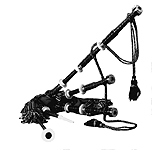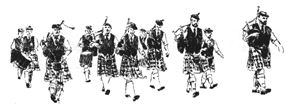

 Let us first look at a brief history of the pipes which is one of the oldest
instruments in existence. One of the earliest sets of pipes were to be found
in Panapolis in Egypt and dated back to 1500 B.C.E. The only older
instruments to be found within a Celtic context are the Bodhran (drum),
clarsach (harp) and feadan (whistle or flute), the latter being perhaps a
forerunner to the pipes.
Let us first look at a brief history of the pipes which is one of the oldest
instruments in existence. One of the earliest sets of pipes were to be found
in Panapolis in Egypt and dated back to 1500 B.C.E. The only older
instruments to be found within a Celtic context are the Bodhran (drum),
clarsach (harp) and feadan (whistle or flute), the latter being perhaps a
forerunner to the pipes.
The actual country of origin of the pipes is not known, its popularity being so widespread all over the world. This was probably due to the Roman empire and its many conquests, for the Roman infantry was known to have pipers within its ranks.Indeed, the pipes were apparently one of the emperor Nero's favourite instruments.
However, there is also the possibility that the pipes were invented independently in each country and so it may be that the instrument was not brought into Alba from the outside. It is true to say that all of the Celtic countries have some history of the pipes as a musical instrument and it may be that, during their travels, the Celtic peoples came across an area where the pipes were already played and adopted the instrument from there.
After the collapse of the Roman empire the pipes remained a popular instrument in Europe for over a thousand years. During this time, the form and shape of the pipes changed as it evolved, resulting in those which are to be found today. The foremost of these is the Highland war pipes and the less well known Chamber pipes and Northumbrian pipes. Like the Irish Uillean pipes, both the Chamber pipes and the Northumbrian pipes use bellows to fill the air bag rather than using the mouth through a blow pipe as in the Highland and Galician pipes. The pipes which use bellows have a more mellow sound best suited to playing indoors as opposed to the much louder Highland war pipes used in places such as the battlefield of Culloden for instance. Indeed, the war pipes are in use today by Scottish Military Battalions who still have pipers in their regiments.
There was a time when the loud Highland pipers became unpopular. Medieval era was the main time when most Europeans started to prefer being indoors where loud musical instruments were not really suitable. This is when the pipes lost out to the harp and other more gentle sounding instruments.
However, during this time of unpopularity, there was a particular nation with whom the pipes remained popular and for them it became their national instrument. This was in the Highlands of Scotland where the older ways of life were more or less retained. With the majority of activities still taking place outside, the louder volume of the pipes was more fully appreciated. This enthusiasm for the pipes by the Scots is such that even today whenever the pipes are mentioned one automatically thinks of Scotland.
If you mention bagpipes and Scotland in the same breath another name springs to mind - the MacCrimmons of Skye. They were hereditary pipers to the clan MacLeod and their contribution to the piping world in many ways helped to develop the evolution of the instrument itself, particularly with regard to the refinement of the music of the pipes.

The big music of the pipes, known as piobaireachd, was developed to an amazing standard by this family, and some of their masterpieces seem immortal. One of the finest is called Cumha na Cloinne or the Lament for the children, composed by Padraig Mor MacCrimmon who lived in the 17th century. Padraig Mor had eight fine sons but one day a foreign ship dropped anchor in Dunvegan with a deadly fever aboard her. This fever spread far and wide over the land of the MacLeods and Padraig Mor lost all of his sons but one in the epidemic. Under the stress of emotion he composed that timeless piobaireachd for his beloved family suddenly lost.
There are many different types of piobaireachd which puts paid to the myth that they are all laments. There are marches, satires, gatherings, rowing tunes (to keep rowers of a galley together) or even battle pieces to celebrate famous victories or incite warriors who are about to engage in conflict.
However, within each piece of piobaireachd there is a common set of stages that must be played for it to be classed as piobaireachd. The first stage is based upon a theme called the Urlar, this stage sets the basis or 'air' of the tune. It is a slow melody which is ornamented by gracenotes. The next stage is known as Siubhal, its function being to transform the melody of the Urlar into a regular rhythmic figure. It is upon this that the third stage, the Taorluath, with its intricate notational patterns can be imposed. This in turn leads to the final and most complex section, the Crunluath, which places on top of the Taorluath an additional three notes to every bar of the music. The difference is almost indiscernible to the non piping ear, yet it adds embellishment to the classical music of the pipes.
The most beautiful pieces of Ceol Mor or Big Music have been preserved by a man called Donald MacDonald, a native of Glen Hinisdale in Skye. In 1805 he published what could be the earliest collection of Ceol Mor in existence. Then in 1839 Angus McKay published his more extensive collection of classical pipe music. In 1900 the late Major General Thompson brought out a small book called Ceol Mor which in its time was called the piping Bible. It is due to these now very rare books that the finest pipe music has been preserved to this day.
To be an accomplished piper was quite a feat or at least having learned from the Boreraig College on the isle of Skye was a major achievement. You had to know by memory at least one hundred and ninety five testing compositions before you were held to have honourably finished the course which normally lasted seven years. The pupils of MacCrimmon were sent to practise in a place known as the pipers hollow - Slochd nam Piobairean - with the view of the Cuillin hills as inspiration.
The history of the pipes is steeped in legend and tradition. It is said that the MacCrimmons were so skilled with the pipes because they had with them a fairy chanter made of pure silver. Its name was Soumsair Airgiod na Mna Sithe - the silver chanter of the fairy woman. This chanter was given to Iain MacOg in a place called the pipers cave. This cave - Uamh nan Piobairean - is where all the great MacCrimmons retired to compose. When they wished to create an outstanding composition they made a vow that they would eat no food until the piobaireachd was completed.
One night when MacCrimmon was fasting in his cave, there appeared the spirit of his ancestor. The spirit piper played him a wonderful tune. In the morning he found he could imperfectly remember the tune. The second night his ancestor appeared again and played the tune to him. This time the human listener received the tune more clearly and on the third night MacCrimmon could remember the tune perfectly. It should be noted that fasting was a common way to achieve an altered state of consciousness. The tune MacCrimmon had learnt he named MacCrimmon's sweetheart, perhaps recognising the source of his inspiration. There was no doubt that MacCrimmon's fasting and meditation had paid off.
Another snippet of tradition tells that pipers usually had a gille or servant to look after their pipes. The reason for this being that when the piper came to the end of his piobaireachd he would throw the pipes disdainfully away, generally over his shoulder, to show in his mind that the music lay in the soul and the fingers of the piper rather than in the pipes themselves. The servant had to catch the pipes and lay them down with more care than the piper himself would. However, if the piper felt that the pipes had let him down, earnest though his playing may have been, he would end his piobaireachd with a skirl of derision to show his displeasure at the pipes. It would seem that the pipes only had an essence of their own when something went wrong!
Copyright - S. Soyka DALRIADA MAGAZINE 1992. Used with permission
Thursday, December 26th, 2019
Attention visitors: Tartans.com is back. Please note that this is a snapshot of the site as it existed nearly 20 years ago and you may encounter broken links; we are still combing through the site and correcting those as we find them. Please also note that some sections are currently not functional, primarily the discussion forums/clan chat boards.
|
** HOME - First Time Visitors - Glossary - - Contact Us ** Awards | Bibliography | Clan Calendar | Clan Chat | Clan Finder | History | Famous Scots | Genealogy | Great Hall of the Clans | Links | News and Features | Scots on the Net | Search | Site Map The Gathering of the Clans
Copyright 1995- Tartans.com - All Rights Reserved. |